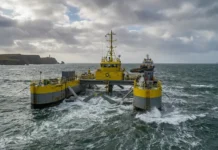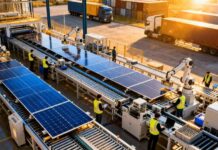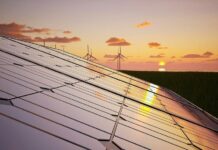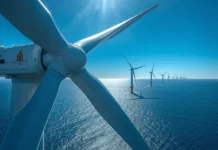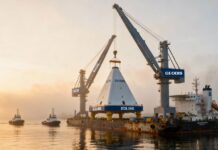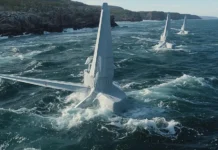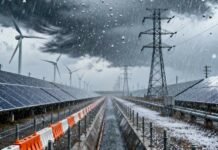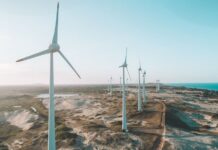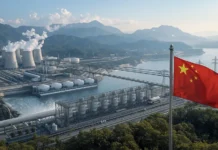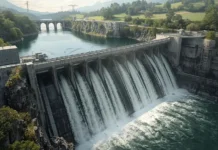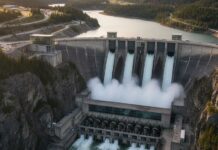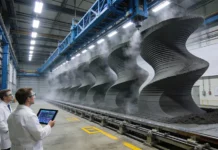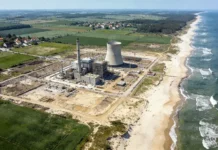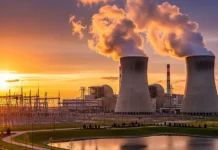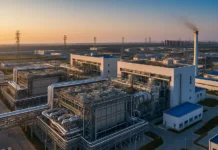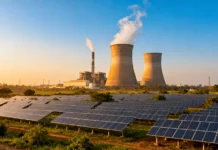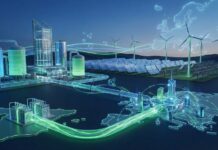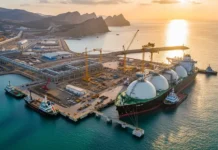There is a construction boom, and this time around, we are talking about wind farms, built out at sea, which are experiencing it.
It is worth noting the global capacity when it comes to wind is anticipated to grow from 81 GW at the end of 2024 to almost 250 GW by the end of this decade. 120 GW of this is going to come from China. Apparently, 37 GW capacity of Europe can as well get doubled to 84 GW by 2030.
The fact is that wind turbines are becoming taller and even more powerful, with some offshore variants now generating enough electricity to power almost 20,000 European homes each.
But as these mammoth structures are put up, the wind industry is also looking to think about how to take down the older turbines, which are almost at the end of their operational life, which is around 25 years.
It is well to be noted that decommissioning turbines on land happens to be a well-established business with a total of almost 2 GW, which is said to get removed in Europe by the end of 2025.
Apparently, only a handful of turbines have been taken out of the sea as of date, which includes the world’s first offshore wind farm, situated in the Danish Baltic Sea, that was built in 1991.
According to WindEurope, it expects the total of the wind turbines removed to only reach 6 MW by the end of 2025. Being the most mature location when it comes to offshore wind across the world, with 37 GW now installed, Europe is going to be the testbed when it comes to decommissioning offshore wind farms. WindEurope goes on to forecast that 29 MW of turbine capacity happens to be in the pipeline in order to get removed by 2030.
Either repower or remove them
It is well to be noted that some wind farms can even have their lifetimes extended by way of refitting their aged components, or turbine blades. Others can also get repowered, which means that all their turbines as well as grid connections get replaced completely. But there is likely to be a limited scope when it comes to repowering because turbines installed at sea decades ago have comparatively smaller foundations. It is worth noting that new turbines that are small enough to fit on these old foundations are going to be an unlikely scenario, says Christoph Zipf, spokesperson from WindEurope.
According to WindEurope, it anticipates only 33 MW of offshore turbines to get repowered by 2030.
One more issue with keeping offshore wind farms in place is that in numerous countries, the seabed in which the turbines get installed happens to be leased from government authorities, and there is no system that is present to extend these leases.
Apparently, the sector is, at present, evaluating the pros and cons when it comes to decommissioning versus refitting or even repowering.
According to a 2023 evaluation that was carried out by the Crown Estate, which goes on to manage seabed leases in most of the UK, it was found that a completely new build offshore wind farm would go on to add the most green electricity generation. Recovering the existing farms would be best in terms of economic value and jobs, whereas extending the lifetime of the existing wind farms would be best in the case of marine habitats and lower use of raw materials.
The present leases happen to last 50 years, and yet there is no offshore wind developer that has applied to extend the lease. If this happens, a decision would be needed in order to take into account the environmental effect, consent from the relevant authorities, and competition when it comes to wind companies.
How about a complete removal?
Fixed turbines can go ahead and make use of concrete or metal foundations. While floating ones happen to involve large seafloor moorings, which involve the same materials. If turbines have to be removed, a major debate is at present under way, which could put forth the fact of whether they should be taken out of the foundations. Another choice is to leave either 2 or 3 m of foundation below the seabed.
According to the CEO of ReWind—a DNV company—Matthew Geraghty, there have been pretty large ecosystems that have gone on to be built up around these structures in the past 20 years, and by way of disturbing those are potentially doing more harm than good.
He goes on to cite a 2020 study by the Technical University of Denmark, which found out that rock-like materials that are applied to the base of the turbine prevent water erosion and offer habitat for biodiversity.
Importantly, the EU has also gone on to install artificial reefs, which are made out of the same material, in order to benefit marine wildlife in other parts of Denmark. According to Geraghty, why would one take it out of water if it has to be put back elsewhere? Apparently, the legal spectrum on the removal question is indeed fragmented. Full removal happens to be favored by international law under the United Nations Convention on the Law of the Sea Act and the Convention for the Protection of the Marine Environment of the Northeast Atlantic.
Most of the national laws in countries having offshore wind, like the UK, Germany, Denmark, Belgium, and the Netherlands, look forward to having a full move. Only France is one country so far that has vouched for partial removal.
It is well to be noted that WindEurope wants the European Commission, which goes on to propose pan-EU legislation, to go ahead and develop an approach throughout the whole 27-country block that enables some kind of infrastructure to remain. This can only happen when there is evidence that it would not only protect biodiversity by avoiding any kind of disturbance during removal of the complete structure but will also actively elevate biodiversity in the future.
A UK-based innovation organization called Offshore Renewable Energy Catapult has recently gone on to evaluate the evidence of the effects of full and partial removal. According to their project engineer, Lorna Bennett, they don’t have enough evidence as of now around the artificial reef argument, for instance, if it presents other environmental concerns around degradation when it comes to metal over the years. There is not enough data to prove either of the cases.
However, the conservation campaigners are really cautious. The head of policy and advocacy at the Marine Conservation Society, which is a UK-based NGO, Calum Duncan, says that any type of decommissioning was preferable when it came to the marine environment to being left as it was before any sort of development had taken place. There are certain occasions where there might be environmental benefits when it comes to leaving structures in place.
He adds that the decision would have to be made on a case-by-case basis, and it will depend on a number of factors, which include the habitat, of course, on which the structures are built, the materials that they are made of, and the cost as well as a benefit analysis in order to remove the structures compared to keeping them in place. There is no blanket approach that is recommended in this case.
WWF – Zeus Ocean policy officer Helena Rodrigues is kind of wary of the wind industry’s claims when it comes to artificial reefs. Although the energy transition is really required, one must make sure that the effect of offshore wind projects is aptly managed. Simply leaving the infrastructure behind does not automatically give the marine ecosystem the advantage. One must focus on reducing harm and making sure that any positive effect is scientifically validated with time.
How about a circular approach?
Yet another big environmental question that is facing industries is how to reuse or even recycle materials as well as components that are coming from the wave of absolute offshore wind farms.
It is worth noting that while 85% to 95% of a turbine can get recycled, as per Danish manufacturer Orsted, the blades still remain a challenge. They are made up of numerous materials, especially balsa or foam core, that are surrounded by layers of fiberglass or carbon fiber. This mixed makeup goes on to make them very hard to break down when it comes to recycling.
There are many manufacturers who have been researching in order to how to design blades for recyclability. Plaswire, which happens to be a northern Irish company, along with Orsted, has collaborated in order to develop a method that involves shredding as well as granulating the blades. They can then get turned into a polymer and be used in the construction industry. Siemens, on the other hand, has gone on to develop a new type of resin, which, according to it, makes Blade recyclable.
As per Zipf, all the main blade manufacturers have also made commitments in order to recycle blades or to have a zero-waste blades scenario by the 2030s or 2040s. The fact is that as these blades become bigger, there is a lot of valuable material that is in there, and it doesn’t make sense to make use of them in a circular manner.
Geraghty says that recyclable blades are still a long shot from being commercially viable, and in any case, they are not the main barrier when it comes to making offshore wind circular. The biggest focus right now for manufacturers is making use of green steel for new turbines because it is very hard to get enough.
Significantly, the entire supply chain has to be considered in order to help clarify green steel, as per Bennet. For instance, in the UK, although steel manufacturers are able to recycle the metal in a domestic way, there are at present no domestic facilities when it comes to manufacturing turbines, towers, or foundations. The recycled steel will have to be shipped to Europe and manufactured so as to be shipped back again.
To encourage the sector to design turbines as well as components with decommissioning and reuse in mind, WindEurope looks forward to governments introducing questions on how wind farm infrastructure is designed in order to enable reuse or recycling during the permitting or auction process.
According to Geraghty, the sector has indeed a strong motivation in order to design turbines with decommissioning and reuse in mind so as to shift the present huge dependence on China for numerous materials. He adds that there is a robust desire to build supply chains within Europe itself.
As far as dealing with the aging of wind farms is concerned, where Europe happens to be going now, other countries have to follow.
The decommissioning challenges of China
It is well to be noted that the offshore wind industry in China has rapidly developed in order to become the largest in the world and happens to be on a similar trajectory as Europe’s.
China’s older wind farms, which happen to be on the land, are going to experience a first peak when it comes to decommissioning in 2025, with more than 1.2 GW of turbines that are expected to retire. Decommissioning offshore wind turbines will be down the line, as it was not until 2010 that China went on to build its first offshore wind farm that was connected to the grid.
As the offshore decommissioning is only on the horizon, both the recycling market and policy are at an infancy stage.
It was in June 2023 that the national energy administration went ahead and issued rules when it comes to upgrading and decommissioning onshore wind farms. However, there are at present no rules for their offshore counterparts. By way of recognizing the mass retirement of turbines that China will soon face, the government has already issued a directive in August 2023. It has commanded numerous bodies in order to build regulations when it comes to decommissioning offshore wind farms and also support research and development when it comes to recycling of both land and offshore sites.
Just like the European counterparts, the wind turbine industry in China also faces the barrier of recycling the massive blades from defunct farms. More than 90% of the decommissioned blades are most likely to end up in landfills or get burned. Although there are Chinese private wind turbine makers, they have already started rolling out blades that are easier to recycle. They can be melted and even separated into their original components by way of a chemical process, thereby allowing the materials to get recycled.
The fact is that the questions Europe is trying to answer when it comes to decommissioning offshore wind will be sooner asked by China along with other countries with an increased urgency.



